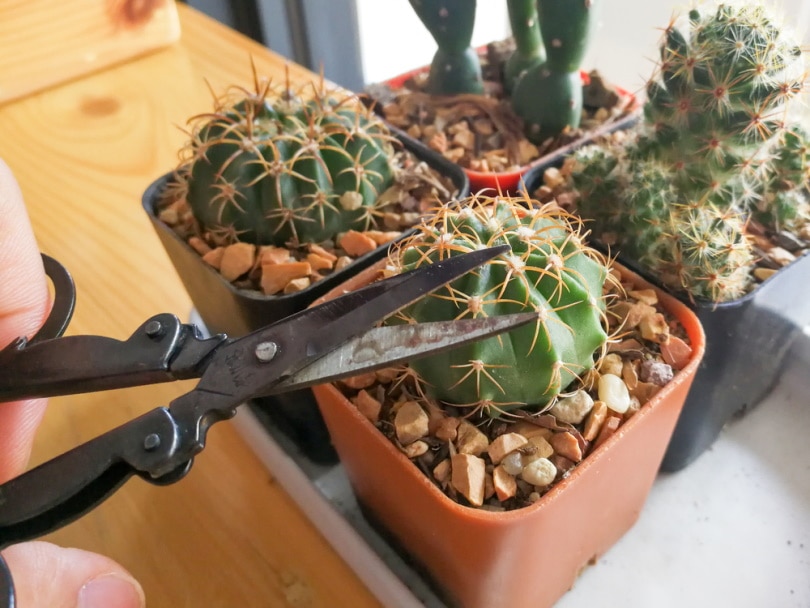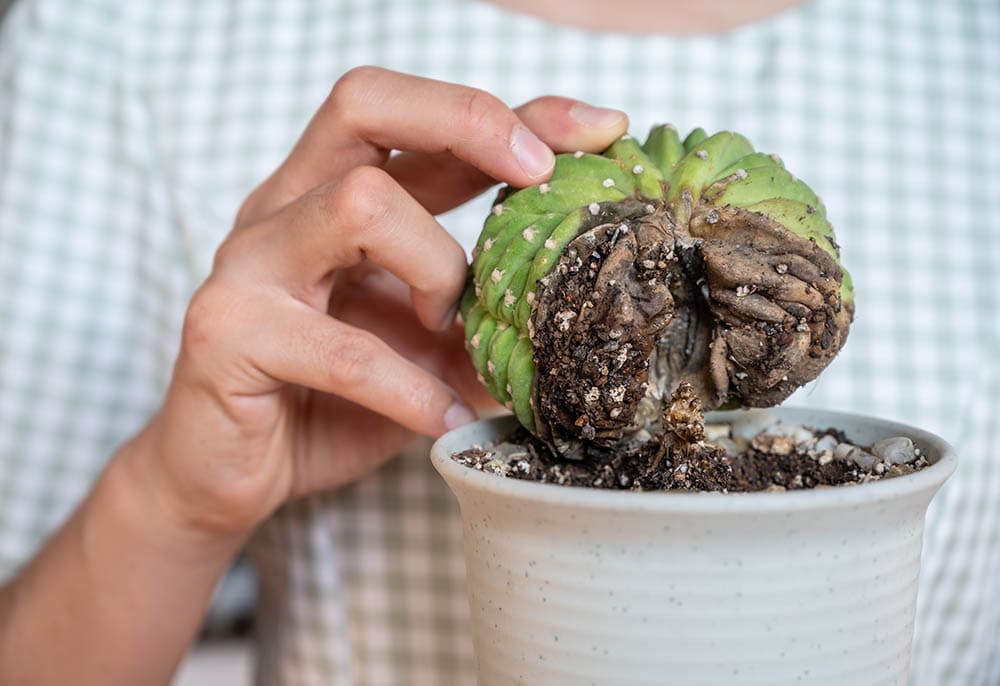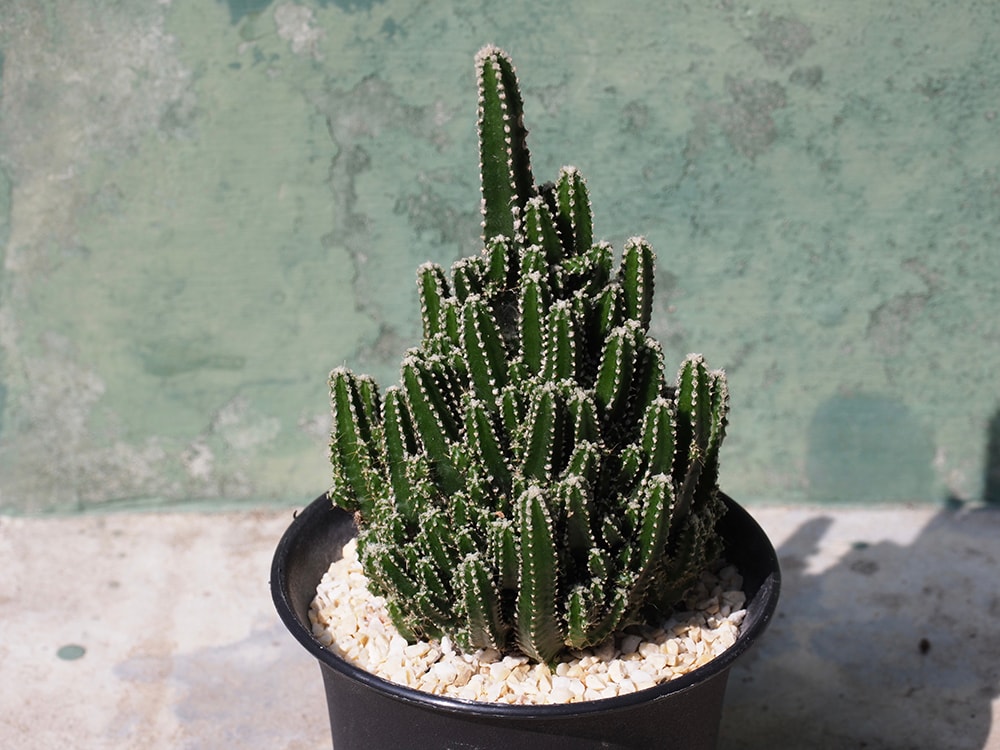How to Trim a Cactus: 5 Tips & Tricks
-
Shea Cummings
- Last updated:

Many people get into growing cacti for their ease of care. The average cactus takes very little attention and can typically withstand a lot of neglect. So, it may be a surprise that these incredible succulents do actually require trimming or pruning from time to time.
There are several reasons that you may want to trim a cactus. For example, if it has diseased or damaged parts, they need to be removed to prevent the potential of disease from spreading. Or, if it’s growing wild, it may not fit within your plan, so trimming it can be a way to make it fit in how you want your garden to look.
This article explores five tips and tricks to trimming your cacti. We’ll also discuss what tools you want to use and discuss a few basic tips on caring for a cactus.
Use the Right Equipment
Trimming a cactus isn’t an overly difficult task. However, due to their prickly nature, you’ll want to take a few precautions before getting started. For example, you’ll want to wear protective gloves when handling most cacti. This includes everything from repotting to trimming. In addition to gloves, it’s often a good idea to tape your cuffs to the glove. This prevents spikes or pieces of the cactus from falling down your sleeve.
The cutting tool depends on what type of cactus you’re cutting. You can probably get away with a set of pruning shears for a small padded or prickly cactus. But a pruning saw is a much better option if you’re trimming a columnar cactus or other large cacti varieties.
One thing to keep in mind if you’re dealing with diseased plants is to keep the tool clean. So, if you’ve already trimmed diseased portions of the cactus, you’ll want to wash the tool in bleach and water solution to prevent disease transmission.
The 5 Tips & Tricks to Trim a Cactus
1. Cactus Trimming Preparation
Before you start hacking, you’ll want to ensure you know why you’re trimming. Cacti can take a long time to regrow, so make a plan before you make your first cut. Are you trying to remove diseased portions? Or are you attempting to make it more desirable in the garden? Asking yourselves these questions will help you decide where to start cutting.
2. Remove Dry or Dead Pieces

Even if there’s no disease, you’ll want to get rid of dried-out or dead pieces of the cactus. These parts are not doing the cactus any good and can actually steal valuable nutrients from the rest of the plant.
3. Trim to Desired Shape
Sometimes, when a cactus grows wild it can begin growing lopsided or unevenly. This isn’t necessarily a problem. However, if you have a certain look you were going for within your garden or the space, you can trim it back for looks. Otherwise, it may grow too heavy on one side and begin to lean, which can actually damage the plant.
4. Trim Just Enough

It’s easy to get carried away trimming and pruning a cactus. But it’s important that you only take what needs to be cut. Suppose you get too aggressive and cut pieces unnecessarily. In that case, you could damage the plant by removing pieces that were providing critical nutrients to the rest of the plant.
5. Discard or Reuse Trimmed Pieces
Dead, dried, or diseased pieces of cacti should be discarded in the trash or compost pile. However, if you trim pieces that are still healthy, you can often reuse them. For example, if you trim off a bit on one side that was getting heavy, you can actually replant that piece, and it will start a new cactus.
You can either plant the piece in a fresh pot or even lay it on top of new soil, and it will take root. Depending on the size of the piece, you may need to let it callus for a few days before planting. Essentially, this allows the cut end to dry out and harden a bit.
 Cactus Care Tips
Cactus Care Tips
Caring for cacti isn’t terribly tricky. Here are a few tips to help your plant thrive:
Adequate sunlight
Cacti love the sun. If you’re keeping them inside, you’ll want to find the sunniest and warmest spot in your house. As long as the lows are above 50° F at night, they will also do well in a sunny perch on your patio. Keep in mind that a cactus can get sunburnt. So, if your plant begins yellowing or browning, move it out of the direct sun to let it cool down.
Adequate Watering
Your cactus needs water, but it should get lengthy breaks between watering. These plants thrive in warm, dry climates. They store water in their stems. A good rule of thumb is when the top 2 or 3 inches of soil in their pot is dry, it’s time to water them.
Believe it or not, a failed attempt at growing a cactus is often due to overwatering. If you make a mistake when it comes to watering your cactus, you’ll want to underwater it more than anything.

High-Quality Soil
You can get special soil mixes designed to give a cactus everything it needs to thrive. If you’re adding fertilizer to the soil, make sure you use one that is formulated for cacti because they have special needs compared to your run-of-the-mill flowers or vegetables.
Careful When Handling
This tip isn’t necessarily for your cactus’ benefit but more for you. A cactus typically has a built-in defense system in the form of spikes or prickly bits. So, if you’re handling it—trimming or repotting—always wear some protective gloves to prevent getting stuck by your plant’s weapons.
Closing Thoughts
Cacti can be very rewarding to grow as they are a unique-looking plant with many variations. And it’s neat that they can be sculpted to a certain degree to fit a certain aesthetic. They are also a very low-maintenance plant, so if you don’t have the strongest green thumb, you probably won’t have too much trouble growing them.
Featured Image Credit: chaithai chaiyanetr, Shutterstock
Contents

